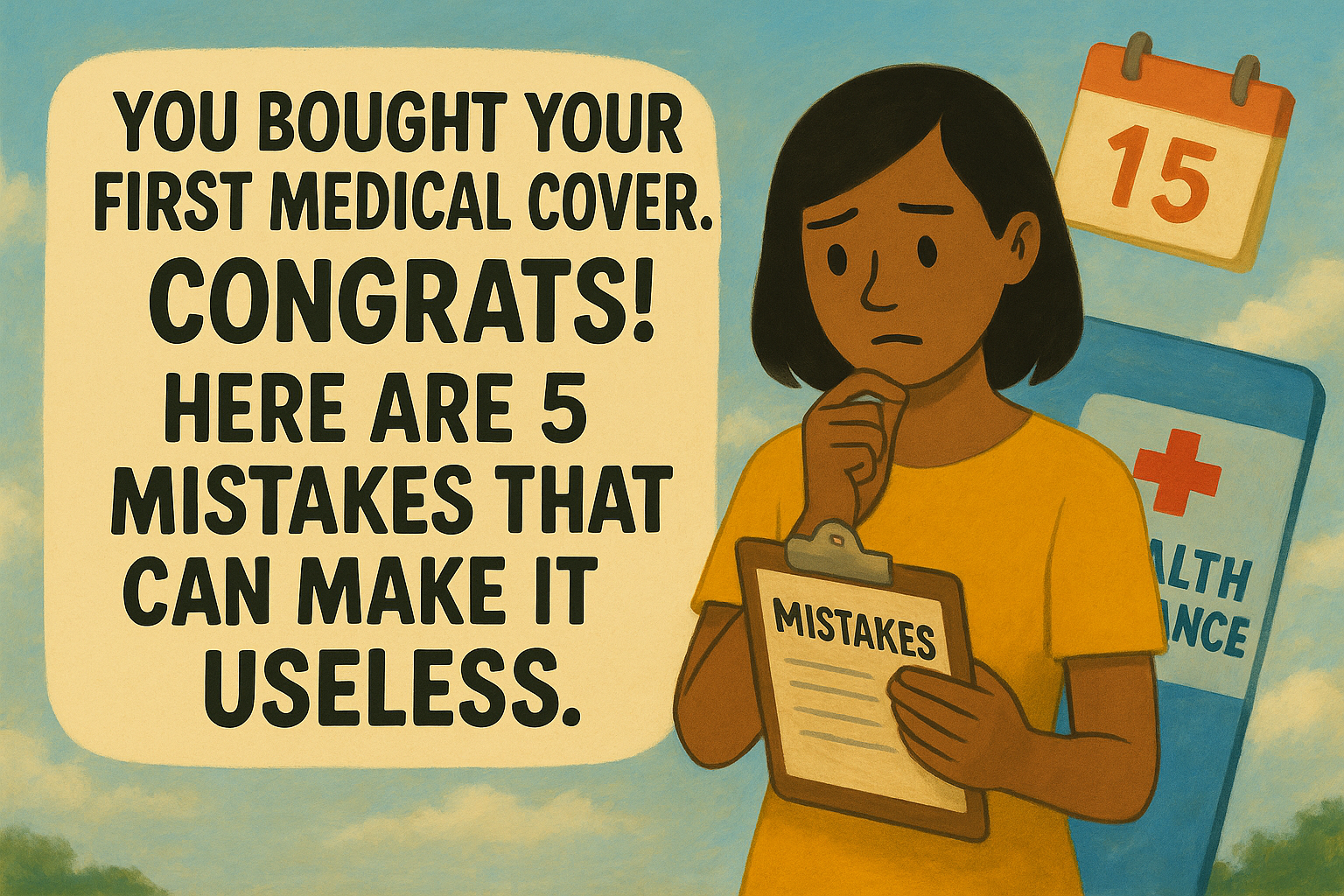You Bought Your First Medical Cover. Congrats! Here Are 5 Mistakes That Can Make It Useless.

Let’s start with this: congratulations. You’ve taken one of the most important steps for your health and your wallet.
But here’s the hard truth: just because you have a medical cover doesn’t mean it will work when you need it most.
The sad stories I hear too often aren’t about people without cover — they’re about people who had a card, thought they were sorted, and still ended up begging on WhatsApp to cover a hospital bill.
Why? Because of a few avoidable mistakes that quietly turn a solid plan into wallpaper.
Let’s make sure that’s not you.
Table of Contents
- Mistake 1: Ignoring the Waiting Periods
- Mistake 2: Picking the Wrong Hospital in a Crisis
- Mistake 3: Forgetting to Renew On Time
- Mistake 4: Hiding Pre-Existing Conditions
- Mistake 5: Not Understanding Sub-Limits
- Final Word: Don’t Just Have Cover — Use It Right
Mistake 1: Ignoring the Waiting Periods
You know those tiny lines in your policy document? The ones you didn’t read because you were so relieved to just get covered? That’s where the waiting periods live.
Here’s the deal:
- General illness waiting period → usually 30 days after your cover starts (accidents are often covered immediately).
- Maternity cover → usually 10–12 months (yes, months) before it kicks in.
- Specific surgeries or chronic conditions → can have 1–2 year waits.
Real-life facepalm:
A couple bought a plan in April when they found out they were expecting. In February the following year, they went to deliver. The hospital checked the dates, shook their heads — maternity cover starts next month.
💡 Fix: Mark your waiting period end dates in your phone calendar. That way you know exactly when each benefit becomes active.

Mistake 2: Picking the Wrong Hospital in a Crisis
When you’re in panic mode — kid burning with fever, spouse in an accident — you just rush to the nearest hospital. Makes sense. But if that hospital isn’t in your insurer’s approved network, guess who’s footing the bill?
Even if your plan has a KES 5M inpatient limit, it means nothing if the hospital won’t accept your card.
💡 Fix: Save your insurer’s approved hospital list in your phone. Share it with your family. Stick a printed copy on the fridge. Emergencies aren’t the time to start Googling.
Mistake 3: Forgetting to Renew On Time
Freelancers, SME owners — this one’s for you.
If your plan lapses for even a few days, and something happens during that gap, you’re on your own.
And sometimes, a lapsed policy means you’re treated as a brand-new applicant — hello again, waiting periods.
💡 Fix: Put your renewal date in your phone with two reminders: one a month before, one a week before. If you can, set up an automatic payment. For SHA/NHIF top-ups, treat it like rent — it’s a must-pay, not a “when-I-remember” expense.
Mistake 4: Hiding Pre-Existing Conditions
I get it — you think if you mention your back problem or high blood pressure, your premium will shoot up or your application will be rejected. But here’s the thing:
- If you don’t declare it, and it comes up in a claim?
- They can (and probably will) deny payment.
Insurers keep records. Hospitals keep records. Don’t gamble.
💡 Fix: Be upfront from the start. If it costs a little more now, that’s nothing compared to being hit with a million-shilling bill later.
Mistake 5: Not Understanding Sub-Limits
Ah, the famous KES 5M inpatient cover. Sounds massive — until you discover it only covers KES 150K for surgery or KES 200K for cancer treatment. That’s called a sub-limit, and it’s where many claims get trapped.
💡 Fix: Read the Table of Benefits line by line. If you see a sub-limit that doesn’t make sense for your health needs, talk to your insurer or broker about adjusting it.

Final Word: Don’t Just Have Cover — Use It Right
Buying your first medical cover is step one. Step two is making sure it actually works when things go left.
So leo, fanya hivi:
- Check your waiting periods.
- Save your hospital list.
- Set your renewal reminders.
- Declare the truth.
- Learn your sub-limits.
Because the only thing worse than not having cover… ni kulipa premiums then bado uanze kuomba M-Pesa help.
🟢 Need a quick “policy check-up”?
I’ll help you review your plan, spot these pitfalls, and make sure you’re actually covered for the things that matter. No jargon, no pressure — just real talk.
Ready to Get Started?
Get personalized advice and quotes tailored to your needs. No pressure, just honest guidance.
👉 Or start a chat with our assistant now.